General
In his own words, John Hench looks back over his career at Disney
As a special treat for JHM readers (as well as a fond tribute to an extraordinary artist), noted Disneyana author Alain Littaye shares a never-before-published interview with the late Disney legend.

Hey, gang!
What a true treat it is to be able to share the following piece with your people. Most of you — I’m sure — already know about Alain Littaye and Didier Ghez’s excellent book about the Disneyland Paris Resort, “Disneyland Paris: From Sketch to Reality.” This full color 320 page volume is considered by most folks to be THE definitive work when it comes to recounting the history of the design and construction of the Paris Resort.
But what you may not be aware of is — as part of their preparation for writing “Disneyland Paris: From Sketch to Reality” — Alain and Didier conducted interviews with dozens of Imagineers. And among the folks that they spoke with was the late, great Disney legend John Hench.
So what follows is a never-before-published interview with Hench that Littaye just pulled from his files. Having just read the thing, I can tell you that this interview does a beautiful job of capturing John’s spirit. His humor. Alain did a really excellent job of capturing John’s essence.
I just want to thank Alain Littaye for offering to share this previously-unseen glimpse into Hench’s career with JimHillMedia.com readers. Me personally, I think that this is a most generous and classy way to honor the memory of an already classy guy. So thanks again, Alain, for sending this article our way.
Speaking of Mr. Littaye … let me get out of the way here, so that he can explain the particulars about this particular interview.
Enjoy!
In 1996, I had the great pleasure of interviewing John Hench in his office at Walt Disney Imagineering. Though he was 87 years old at that time, John looked incredibly elegant and, of course, was very kind.
At the time of this interview, Hench was choosing the colors to be used on the Magic Kingdom castle during the Walt Disney World resort’s 25th anniversary celebration.
The really great thing about talking with John is that he always spoke his mind. He never adhered to the Disney party line.
That’s why I’m pleased to share with JimHillMedia.com readers this last tribute to one of the greatest Imagineers. This never-before-published interview with John Hench.
ALAIN LITTAYE: How did you enter the Walt Disney Company?
JOHN HENCH: Well, it happened in 1939. I have wanted to be a fine artist painter, and I reached the point in art schools were I’d like to understand more about images and how images communicate information to people. And I was not getting very far in that from my professors.
So I thought that it would be easier to learn that (if) I worked in motion pictures. So I went to work with one motion picture producer who was developing a color system. This didn’t do to me much good. All I did was pick (out) filters for the camera. The other (thing I tried) was working for special effects. Which was not what I was looking for.
So I finally came to Disney, who was hiring people for “Fantasia.” I like classical music, so I thought “This is fine.” And I found what I was after, because the studio had developed a great skill in producing images that have great meaning for people.
Mickey is one of the prime examples: Mickey has never been suspected of being an American export. It was déjà vu. They gave him (a) local name and he’s been accepted everywhere he goes. Even in China. Children there, next to the Great Wall, who had never seen Mickey Mouse responded. So the studio did (have) that skill to communicate with images.
Of course, it gave the studio an enormous power, because I don’t know any other place — at that time — who had that skill with images to communicate with. And the need of these kinds of images are even greater now than they ever were because we are losing our life symbols. We don’t have too much ritual in our life anymore. And these life symbols which people rely on to keep their feeling of well being, that life is not too bad after all are required more and more….
AL: You went through a record number of different jobs while you worked at Disney. Which one did you enjoyed the most?
JH: I enjoyed all of them! I still enjoy all of them! But I was curious about how did it work, how did it function. And so I went from one job to another …
Even the camera (department). One day, I (told) Walt : “I would like to work on camera for a while.” He said “Well, really? What for?” And I explained to him that some of the scenes — I was in background painting then — didn’t come out right. And I thought they had lit them wrong, particularly on the multiplane camera. So Walt said “Fine,” and I stayed there for three years.
And I (helped) develop (Disney’s) special effects department at that time, (which) helped very much when we worked on “20000 Leagues under the Sea.”
Then I started to work on Disneyland, on the idea of a theme park. Walt said one day when he walked by my desk “I want you to work on Disneyland … And you are going to like it!” And he kept on going. I didn’t have even a chance to answer!
But I did like it. Because it was much the same — the same kind of things achieved (in) the movies (but) in another way — three dimensional. We have the long-shot when you’re coming in, then people come to the close-ups. When you’re going from Main Street to Adventureland, there is a threshold. The painting is different, you get information from your feet that you are crossing something, and the music is different, etc. Walt put everything he knew about communication with images into the park, so it was very familiar.
AL: When I am trying to explain to people in France who have never been in the park, I always tell them that Disneyland is a kind of accomplishment of the love of men for illusion. After the magicians in the ancient times, the modern magic from Robert Houdin, then came the cinema, and finally the theme park concept. Which is a kind of three dimensional illusion…
JH: That’s right. And it achieved a kind of reality. Like these virtual reality games the children are playing with. I told them we were doing this 40 years ago! Disneyland is virtual reality…
Walt had a marvelous intuition. And because he understood people very well, liked them and had great respect for people, there was nothing cynical about Walt. In other studios I worked for, they were all cynical! When they did bad pictures, they were saying: “They won’t know the differences!” But it¹s wrong, (people) do see the difference, and it’s because they have feelings. They don’t see it from the intellect, but from feelings.
And Walt understood all of those things, and even common things about people. For instance: Usually you get your idea of what kind of day it is by looking at the horizon, because the horizon is your (eye) level. So what Walt did is to eliminate the horizon. When you go to the park, there is no horizon — just Disneyland.
And so the environment is very special, because nothing leaks in from outside. Even the sun is brighter! You have an impression of better weather inside the park than you do outside.
You know, since we’re born, the first thing we fight for in life is that feeling of being alive — and it’s the last thing, too. We never want to give up that experience of being alive. And this is the secret of Disneyland: Everywhere in the park, it’s like a pat in the back telling you: “You’re okay. Life is good.”
We’ve achieved this feeling, for instance, with the colors. The colors in the park are harmonious with each other, not like in big cities where they don’t. Big cities are chaotic. And chaos for humans — who have experience from their ancestors — is the last step before conflict. So, in the park, every kind of visual contradiction has been eliminated.
We were trained from (our work with) cartoons. Everything who was on the screen was chosen. Anything who was not there was deliberately not there. In live action movies, you just hope that everything works. Because the actor may had a bad morning and (doesn’t) play good, or accidents happen continuously. Many things contradict what you are trying to say. But in cartoons, nothing contradict what you want to say. And I think that’s why Walt (got) into cartoons, because he knew he (would) have control. A director (doesn’t) have much control, really. Only a little. Except maybe some great directors like Stanley Kubrick or David Lean. Because they’re fighting for …
AL: Talking about movies: You told me before that you worked on “20000 Leagues under the Sea.” What kind of special effects were you involved?
JH: Well, there were a lot of special effects as you know. I did what we call dry for wet effects, some of the miniatures work and two animation sequences.
I even took the place of the actor who played Professor Arronax. It’s the scene where Professor Arronax is sitting in his cabin, making an entry in his diary about a storm overhead on the surface, but quiet and calm where they were underneath the water. We could not find (Paul Lukas) that day. So I put on a coat and played his role. Actually, it’s my hand that you see writing on the diary. Not in spencerian script, because I didn¹t had time to practice. You’ll see it in the movie.
AL: There is this famous never finished animated project call “Destino,” on which you worked…
JH: Oh, “Destino”! Yes, it was with Salvador Dali. The theme of “Destino” was about space, time and love. It was supposed to be 10-12 minutes long, and included (in) what they called at that time a package picture, with a number of short subjects that make all together a long feature. It was supposed to be with “Three Caballeros,” “Make Mine Music,” etc. But at that time, suddenly our distributor — RKO — didn’t want any more of (these package pictures). So Walt reluctantly suspended (on the film).
So there is only the story (plus) a 30 second test that I did. Because I thought that — when Walt had (seen these) images on the screen — he might want to go ahead with (production of the picture). I shot a test with Dali. It was supposed to be animated, but I didn’t had any animator! So we did something which was more animation effects than real animation.
But the story was complete as (were) the storyboard too. And even the plans for production. Walt was sorry afterwards. He said we should have gone ahead and made it anyway. Because of the value of the document.
But working with Dali was wonderful. We shared the same sense of irrationality. He came every day at the studio for about a year. There were breaks in between of course, where he went back to his home in Spain. I went up there. We were good friends and we did many other things later. I helped him for the “Leda and the Swan” painting, for instance. He was not good at perspective of shadows. I helped him on several canvases…
AL: What was the origin of the project?
JH: Dali was working for Warner Brothers on the Hitchcock movie (“Spellbound”), and he stayed at Jack Warner’s house in Beverly Hills. And Walt met him at dinner, because Jack Warner and Walt were friends. And Walt asked him if (Salvador) would like to come over and do something for us. (Dali) said “Yes.” And so he came at the studio.
We had a piece of music, and Walt said “Why don’t we make a short animated out of this?” And that’s how it happened. The music was very banal, but Dali didn’t mind, because he knew he could (get a) handle on anything. He could take the banality out of anything!
The fact is that (Salvador) enjoyed banal things, really. He was crazy about the western pictures, the worst ones in the world. And he reinvented the whole story. From the stampede and the long horn cattle, he will tell you that — in fact — it was all about the libido of one of the actors!
So he was never bored by anything, because he re-interpreted. One of the things he was doing was taking the dictionary and making a Dali equivalent for every word. He reinterpreted each word in a “Dalinian” manner and gave it a new meaning! This is a tremendous work!
But Walt and him shared the same kind of optimism. Walt believed in himself, and he was optimistic about what he wanted to do. He just knew it will be okay, and Dali was the same way. They had a great deal in common that way.
AL: Can you tell us about the Disneyland attractions projects you work on and that were never built?
JH: Well, nothing really important. Nearly everything was built. One was ten years later and … Of course, there is this Chinese restaurant project with a golden dragon and Confucius to entertain guests. Both of them were Audio-Animatronics, and Confucius was there to answer wisely to questions. It was supposed to be in the second street project for Main Street. But who knows? Maybe it will be built one of these days. We never throw away any idea…
For instance, some early ideas for Florida were done only recently. The idea of a little village was there from the beginning and now we have this “Celebration” village. Same thing for the Disney Institute. Walt talked about this idea in the very first.
Some other ideas had changed from their initial concept. The “Tiki room,” for instance, was supposed to be a Polynesian restaurant. I had ordered tables, I had bought all the furniture. And Walt was listening one morning to a rehearsal of the show, and he said: “If we get rid of the tables, how many more people can we get in here?” So I took the tables out, arranged the chairs in a certain way, etc. … And he said: “That’s what we gonna do. I’ll handle the man who was to operate the restaurant. So we (can) make a show out of it.”
But the (“Enchanted Tiki Room”) show was all done, and it was a show who didn’t had a curtain riser. It didn’t had a start. It was supposed to (start up) very gradually. Walt’s idea was that — as soon as the people who were dining got through their main course (They were supposed to all be seated, served at the same time), when they got into the dessert … This music (that was supposed to only come from tapes like in any restaurant) … Something would happened. One bird will start to do a little jazz thing, and another bird will start to answer. And people would have say: “Something is going on here! What is this?” and the show would have come very gradually…
But, with no restaurant, you can’t make a show like that. It must have an overture. And we tried to do something about that (right up) until the last minute before (the “Tiki Room” ‘s official) opening.
The show is being changed right now, by the way. Jeff Burke is doing it for the Magic Kingdom. And I think it will be better, with new birds, master of ceremonies, etc. …
In the first version, we had to pretend that he birds were asleep. Somebody came in saying “Hey, wake up, wake up!” And we started the show that way which was very bad. I was always embarrassed about this. Because you can’t design a show for one operation and then make a change so radically.
And not to mention this Offenbach music in the middle. Which is incredibly boring! I remember that I protested. I’m not a musician myself. But we had a big fight, the composer who did the music and me. His name was Buddy Baker. I’ll never forget him!
AL: Do you have memories about the original Epcot project?
JH: I worked on the concept, the first layouts and designs for the property. I worked on all the attractions concept. I remember that — at the beginning — we had two separate models for Future world and world showcase. And Marty Sklar pushed them together, and we combined them.
I don’t think that was too successful. Because I always thought that the two of them should have been more separate. Also I had planned the monorail station to be in the center. So that one day you would have (had to) go to World Showcase and then the other day to Future World. And I still think (that) would have been better.
AL: What was your worst challenges on your works for Walt Disney world?
JH: Well, I suppose that every time there is difficulty. I remember about Space Mountain: It took us ten years before we found the technology that (would) allow such a ride. And during these ten years, I had a model that I kept, waiting for the technology we needed.
And one day, we finally found out the technique of separating and getting information about where every train (would be) at any moment. Of course, I went over budget many times, because — as you go along — some things improved, and you get better ideas. And you get advantage of what is there and all that cost money.
When we started a project, all my focus was on it, night and day. You never forget it until it¹s done. I suppose I always had a passionate relation with the projects. Because, you know, it’s never a hard work when you enjoy yourself. Look, I’ve been here since 57 years, and I don’t have to explain why I’ve stayed so long. I always enjoyed it.
AL: I can understand that. Where else somebody can give you 100 millions dollars to build some big toys?
JH: Nowhere, that’s right. And no place where they believe in big toys.
AL: What is your favorite achievement on Walt Disney World?
JH: Usually, it’s the last thing I’ve worked on. Now, I worked on colors. Color is a very critical thing. I’ve found that architects don’t like colors. Engineers too. And so somebody has to stand in. Because this is the finish of it. It is the emotional part of a structure. I had great satisfaction in doing that.
AL: Sam Mc Kim was a specialist of western theming, Marc Davis was famous for the humor he introduce in the attraction. What was your specialty?
JH: Well, I suppose that I was a kind of consultant for taste. Is it good taste? Or bad taste? I had an attention to detail, to what would tell best the story. Because many people get excited about the work and drift off from the story.
Like “Pirates of the Caribbean,” for instance. When you get in, you see on the door: “Pirates of the Caribbean.” (So you expect to see pirates. Then you get on the boat, so you think: “This is okay. We’re going to see pirates.” The boat goes out and the first scene that you see is the restaurant. So people think: “Hey, these are not pirates. These are people having lunch. What happen to the pirates we are supposed to see?” Then we go down the chutes , and it’s where the pirates were. But they’re all gone. There is nothing but skeletons down here!
Well, it was never supposed to be like that. Walt died before we had finished. The original idea of Walt’s was that you came down there, into the caves, and there were no pirates … But they had been there just seconds before! There was a hot meal on the table, steaming. There were no jewelry hidden. Walt wanted this atmosphere: They were supposed to live here, they’ve been outside somewhere, but they could come back at any minute and catch us…
Then, you were supposed to discover the city, where they were. But because somebody like skeletons. And that they discovered that they were (available) at a cheap price, we used too many skeletons all over the place, and (the public) got the wrong message. Now people don’t know what it was…
AL: In the Paris version, they put the skeleton at the end, not at the beginning.
JH: Well, at least they’ve learn something!
AL: Have you been to Disneyland Paris?
JH: Yes, I like it. The colors I choose there was to paint the first hotel, the Disneyland Hotel. Because of the cloudy sky we had in Paris, it had to be a particular kind of color who will fight those grey days. And also something you can see when you’re driving up … “There it is! We’re arriving! ” And I think it works well. Better than the castle. Someday, we’ll have to paint this castle all over again!
AL: You knew Ray Bradbury who helped the Imagineers on the Orbitron concept. What was your relation with him?
JH: Ray is a good friend. And he was a good friend of Walt, too. We worked on several things for the world’s fair together, on some of the exhibitions for industrial companies, and we’re still consulting him occasionally. In fact, I think the studios are working on a cartoon picture from one of his books. He has talked with Roy Disney about it. But I don’t know at what point is the project.
AL: What are you currently doing at WDI?
JH: Well, I happen to be working on two hotels. One is being rehabbed, repainting.And the other one is a large one. 1900 rooms, themed on the Southwest of the United States. New Mexico, kind of. It’s an enormous amount of work: there are 28 separate buildings, and I work on the choice of the colors for everything. Outside colors, balcony colors, etc.. And all of this has to work together, in harmony.
I work also on the WDW castle. We are going to make a big cake out of it for the 25th anniversary. It’s a big work. The logistic of that is just enormous.
AL: What is your fondest memory of Walt?
JH: I always admired his optimism. He seemed to know the direction he was going to. When I was at the studio, I remember he kept driving all of us back down to a more fundamental level all the time. When we tried to use — let’s say — an event that was current, he said: “No, don’t use that! It’s all right for now. But I want these pictures to come back for years and I want them to have a meaning. If you use that now, it will be okay for today. But four or ten years from now, what will it mean?” And he was right: We still can release a 40 years old picture, and it’s still good because it still has meaning.
Another memory I have is when I was working on a Stravinsky animation adaptation. It was supposed to be a ballet, and I didn’t like it. Walt said “Why?” And I told him that I didn’t know anything about ballet. And he said “Oh….Well, here is what I want you to do.”
And (Walt) called the impresario of the Ballet Russes of Monte Carlo. And he arranged for me to go sit back stage for the whole season! For all the performances! And I made a thousand drawings, went back, and did my job without any complain.
(Walt) often did these kinds of things. Like letting me go (to work) down (in) the camera department. Who does this now? Nobody! You have a job, and you stay on it all your life now. Nobody now is going from department to another department. Only Walt did that.
I was very fond of him, really…
Interview recorded June, 24, 1996 by Alain Littaye, with the friendly help of Didier Ghez for the questions.
General
Seward Johnson bronzes add a surreal, artistic touch to NYC’s Garment District

Greetings from NYC. Nancy and I drove down from New
Hampshire yesterday because we'll be checking out
Disney Consumer Products' annual Holiday Showcase later today.
Anyway … After checking into our hotel (i.e., The Paul.
Which is located down in NYC's NoMad district), we decided to grab some dinner.
Which is how we wound up at the Melt Shop.

Photo by Jim Hill
Which is this restaurant that only sells grilled cheese sandwiches.
This comfort food was delicious, but kind of on the heavy side.

Photo by Jim Hill
Which is why — given that it was a beautiful summer night
— we'd then try and walk off our meals. We started our stroll down by the Empire
State Building
…
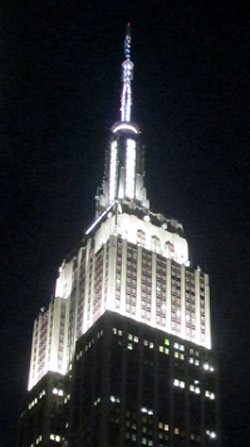
Photo by Jim Hill
… and eventually wound up just below Times
Square (right behind where the Waterford Crystal Times Square New
Year's Eve Ball is kept).
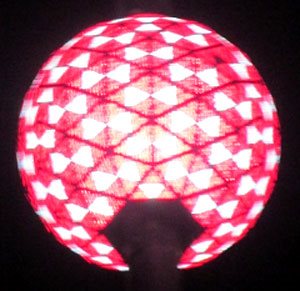
Photo by Jim Hill
But you know what we discovered en route? Right in the heart
of Manhattan's Garment District
along Broadway between 36th and 41st? This incredibly cool series of life-like
and life-sized sculptures that Seward
Johnson has created.
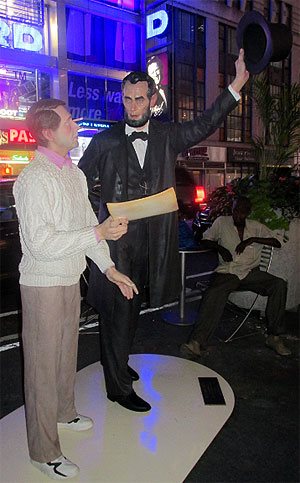
Photo by Jim Hill
And — yes — that is Abraham Lincoln (who seems to have
slipped out of WDW's Hall of Presidents when no one was looking and is now
leading tourists around Times Square). These 18 painted
bronze pieces (which were just installed late this past Sunday night / early
Monday morning) range from the surreal to the all-too-real.
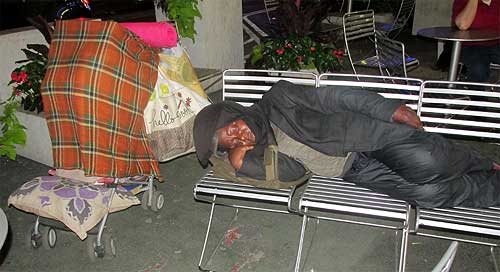
Photo by Jim Hill
Some of these pieces look like typical New Yorkers. Like the
business woman planning out her day …
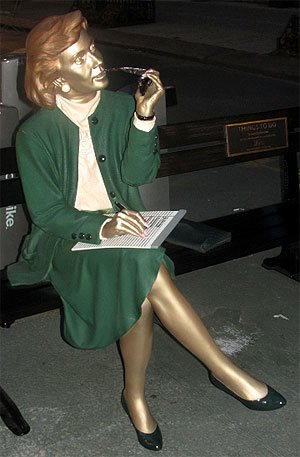
Photo by Jim Hill
… the postman delivering the mail …
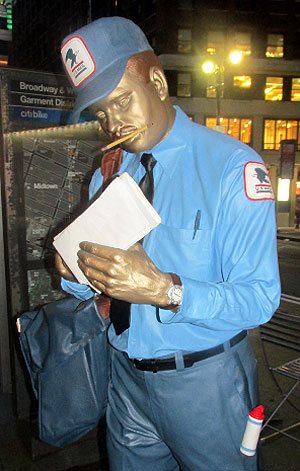
Photo by Jim Hill
… the hot dog vendor working at his cart …

Photo by Jim Hill
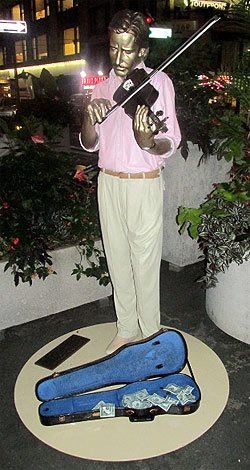
Photo by Jim Hill
… the street musician playing for tourists …
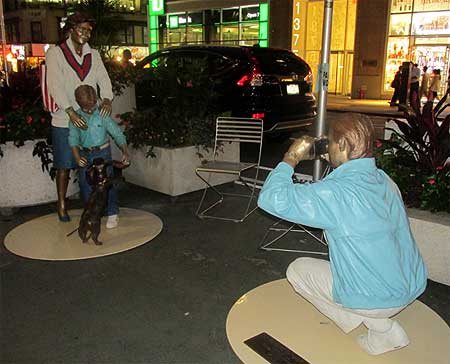
Photo by Jim Hill
Not to mention the tourists themselves.

Photo by Jim Hill
But right alongside the bronze businessmen …
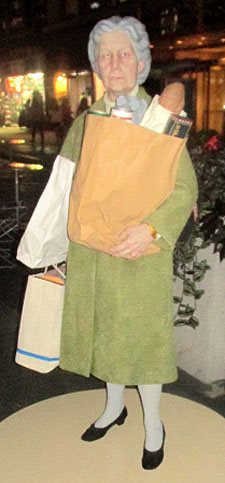
Photo by Jim Hill
… and the tired grandmother hauling her groceries home …
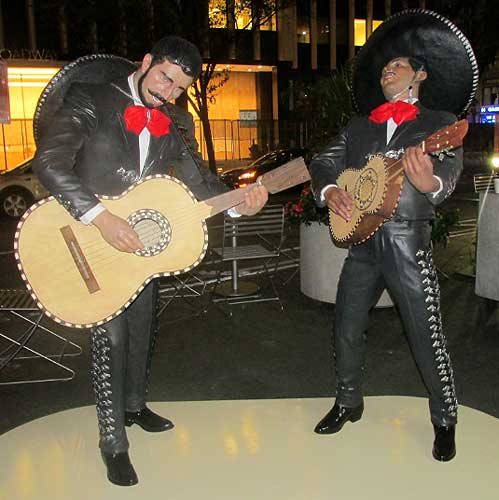
Photo by Jim Hill
… there were also statues representing people who were
from out-of-town …
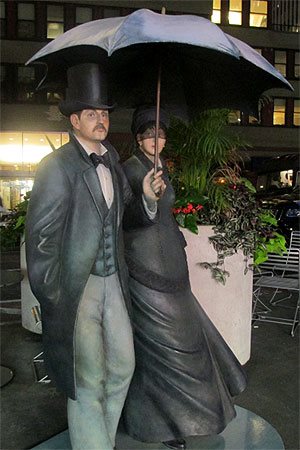
Photo by Jim Hill
… or — for that matter — out-of-time.
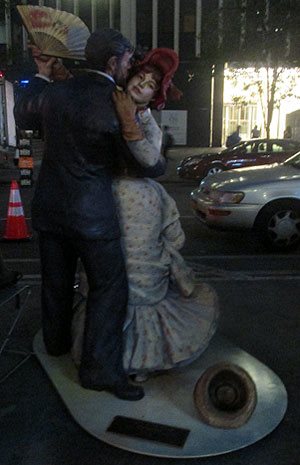
Photo by Jim Hill
These were the Seward Johnson pieces that genuinely beguiled. Famous impressionist paintings brought to life in three dimensions.
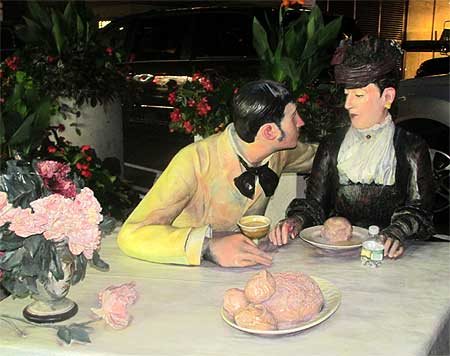
Note the out-of-period water bottle that some tourist left
behind. Photo by Jim Hill
Some of them so lifelike that you actually had to pause for
a moment (especially as day gave way to night in the city) and say to yourself
"Is that one of the bronzes? Or just someone pretending to be one of these
bronzes?"
Mind you, for those of you who aren't big fans of the
impressionists …
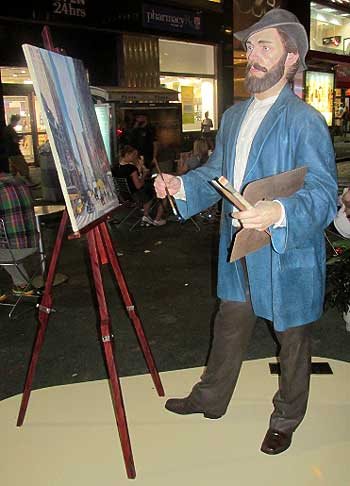
Photo by Jim Hill
… there's also an array of American icons. Among them
Marilyn Monroe …

Photo by Jim Hill
… and that farmer couple from Grant Wood's "American
Gothic."
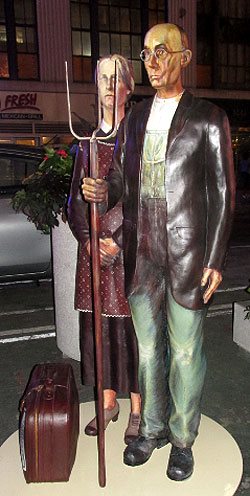
Photo by Jim Hill
But for those of you who know your NYC history, it's hard to
beat that piece which recreates Alfred Eisenstaedt's famous photograph of V-J Day in Times Square.

Photo by Jim Hill
By the way, a 25-foot-tall version of this particular Seward
Johnson piece ( which — FYI — is entitled "Embracing Peace") will actually
be placed in Times Square for a few days on or around August 14th to commemorate the 70th
anniversary of Victory Over Japan Day (V-J Day).
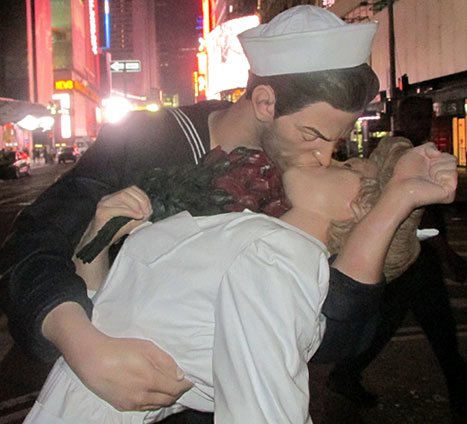
Photo by Jim Hill
By the way, if you'd like to check these Seward Johnson bronzes in
person (which — it should be noted — are part of the part of the Garment
District Alliance's new public art offering) — you'd best schedule a trip to
the City sometime over the next three months. For these pieces will only be on
display now through September 15th.
General
Wondering what you should “Boldly Go” see at the movies next year? The 2015 Licensing Expo offers you some clues

Greeting from the 2015 Licensing Expo, which is being held
at the Mandalay Bay
Convention Center in Las
Vegas.

Photo by Jim Hill
I have to admit that I enjoy covering the Licensing Expo.
Mostly becomes it allows bloggers & entertainment writers like myself to
get a peek over the horizon. Scope out some of the major motion pictures &
TV shows that today's vertically integrated entertainment conglomerates
(Remember when these companies used to be called movie studios?) will be
sending our way over the next two years or so.
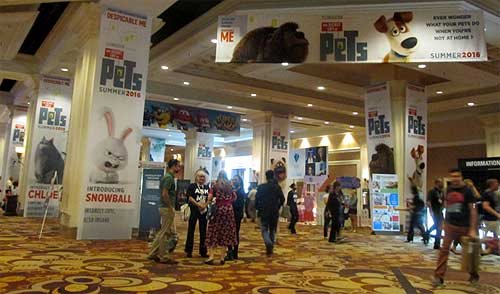
Photo by Jim Hill
Take — for example — all of "The Secret Life of
Pets" banners that greeted Expo attendees as they made their way to the
show floor today. I actually got to see some footage from this new Illumination
Entertainment production (which will hit theaters on July 8, 2016) the last time I was in Vegas. Which
was for CinemaCon back in April. And the five or so minutes of film that I viewed
suggested that "The Secret Life of Pets" will be a really funny
animated feature.
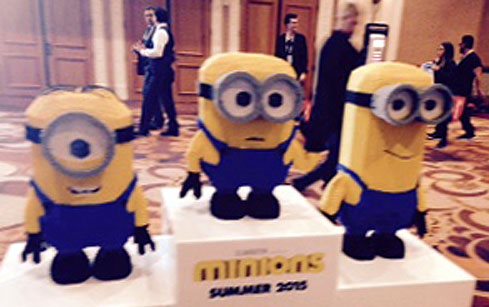
Photo by Jim Hill
Mind you, Universal Pictures wanted to make sure that Expo
attendees remembered that there was another Illumination Entertainment production
coming-to-a-theater-near-them before "The Secret Life of Pets" (And
that's "Minions," the "Despicable Me" prequel. Which
premieres at the Annecy International Animated Film Festival next week but
won't be screened stateside 'til July 10th of this year). Which is why they had
three minions who were made entirely out of LEGOS loitering out in the lobby.
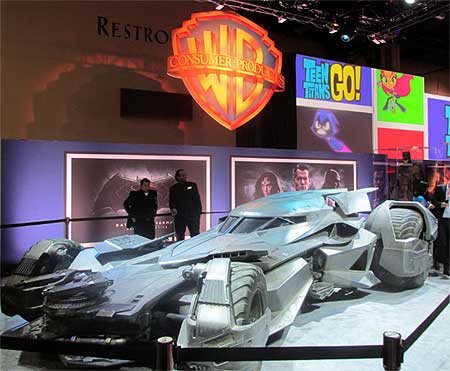
Photo by Jim Hill
And Warner Bros. — because they wanted "Batman v
Superman: Dawn of Justice" to start trending on Twitter today — brought
the Batmobile to Las Vegas.
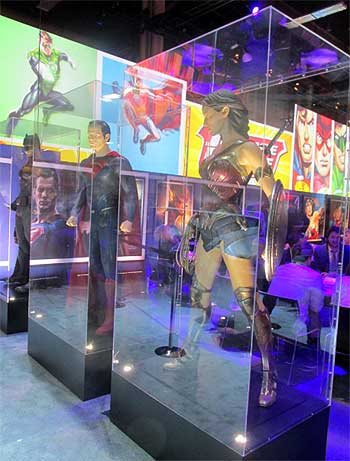
Photo by Jim Hill
Not to mention full-sized macquettes of Batman, Superman and
Wonder Woman. Just so conventioneers could then see what these DC superheroes
would actually look like in this eagerly anticipated, March 25, 2016 release.
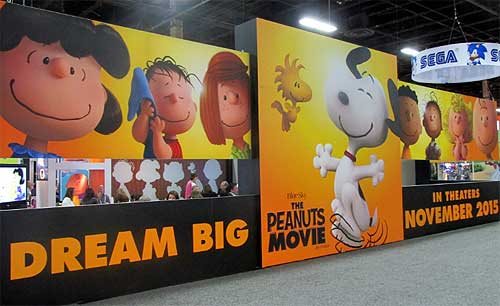
Photo by Jim Hill
That's the thing that can sometimes be a wee bit frustrating
about the Licensing Expo. It's all about delayed gratification. You'll come
around a corner and see this 100 foot-long ad for "The Peanuts Movie"
and think "Hey, that looks great. I want to see that Blue Sky Studios production
right now." It's only then that you notice the fine print and realize that
"The Peanuts Movie" doesn't actually open in theaters 'til November
6th of this year.
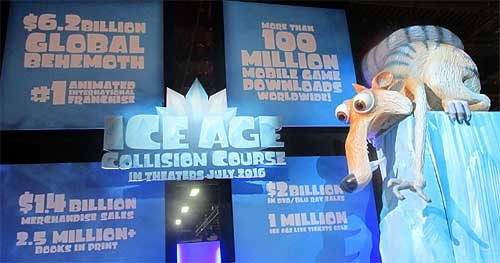
Photo by Jim Hill
And fan of Blue Sky's "Ice Age" film franchise are in for an even
longer wait. Given that the latest installment in that top grossing series
doesn't arrive in theaters 'til July
15, 2016.
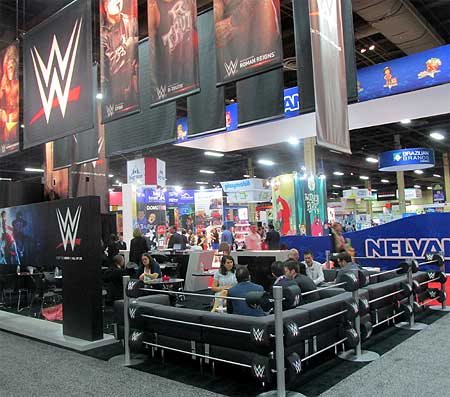
Photo by Jim Hill
Of course, if you're one of those people who needs immediate
gratification when it comes to your entertainment, there was stuff like that to
be found at this year's Licensing Expo. Take — for example — how the WWE
booth was actually shaped like a wrestling ring. Which — I'm guessing — meant
that if the executives of World Wrestling Entertainment, Inc. didn't like
the offer that you were making, they were then allowed to toss you out over the
top rope, Royal Rumble-style.

Photo by Jim Hill
I also have to admit that — as a longtime Star Trek fan —
it was cool to see the enormous Starship Enterprise that hung in place over the
CBS booth. Not to mention getting a glimpse of the official Star Trek 50th
Anniversary logo.
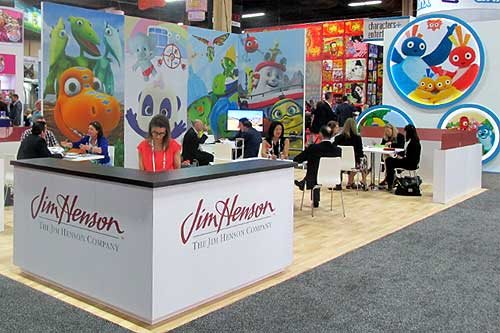
Photo by Jim Hill
I was also pleased to see lots of activity in The Jim Henson
Company booth. Which suggests that JHC has actually finally carved out a
post-Muppets identity for itself.
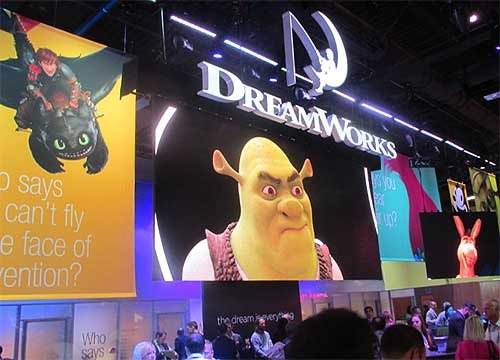
Photo by Jim Hill
Likewise for all of us who were getting a little concerned
about DreamWorks Animation (what with all the layoffs & write-downs &
projects that were put into turnaround or outright cancelled last year), it was
nice to see that booth bustling.
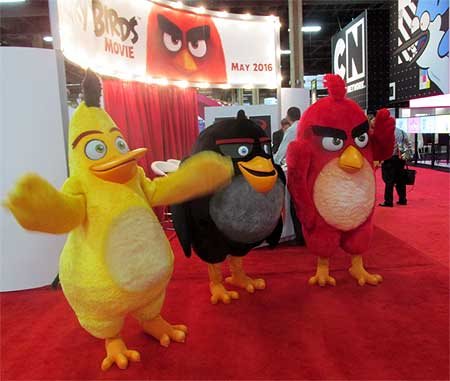
Photo by Jim Hill
Every so often, you'd come across some people who were
promoting a movie that you weren't entirely sure that you actually wanted to
see (EX: "Angry Birds," which Sony Pictures Entertainment / Columbia
Pictures will be releasing to theaters on May 20, 2016). But then you remembered that Clay Kaytis —
who's this hugely talented former Walt Disney Animation Studios animator — is
riding herd on "Angry Birds" with Fergal Reilly. And you'd think
"Well, if Clay's working on 'Angry Birds,' I'm sure this animated feature
will turn out fine."
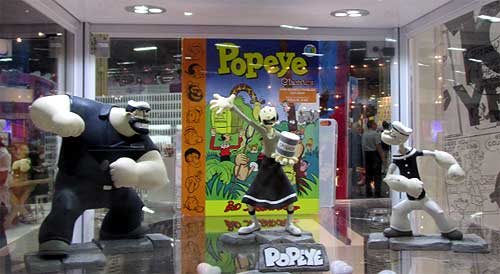
Photo by Jim Hill
Mind you, there were reminders at this year's Licensing Expo
of great animated features that we're never going to get to see now. I still
can't believe — especially after that brilliant proof-of-concept footage
popped up online last year — that Sony execs decided not to go forward
with production of Genndy Tartakovsky's
"Popeye" movie. But that's the
cruel thing about the entertainment business, folks. It will sometime break
your heart.
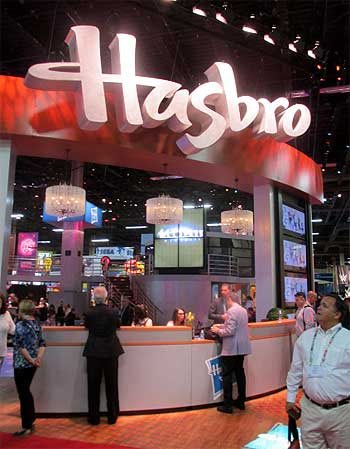
Photo by Jim Hill
And make no mistake about this. The Licensing Expo is all
about business. That point was clearly driven home at this year's show when —
as you walked through the doors of the Mandalay
Bay Convention Center
— the first thing that you saw was the Hasbros Booth. Which was this gleaming,
sleek two story-tall affair full of people who were negotiating deals &
signing contracts for all of the would-be summer blockbusters that have already
announced release dates for 2019 & beyond.
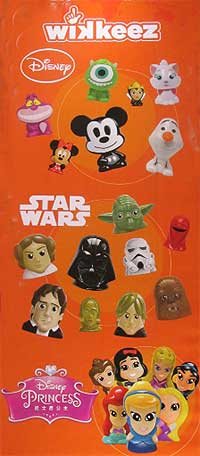
Photo by Jim Hill
"But what about The Walt Disney Company?," you
ask. "Weren't they represented on the show floor at this year's Licensing
Expo?" Not really, not. I mean, sure. There were a few companies there hyping
Disney-related products. Take — for example — the Disney Wikkeez people.
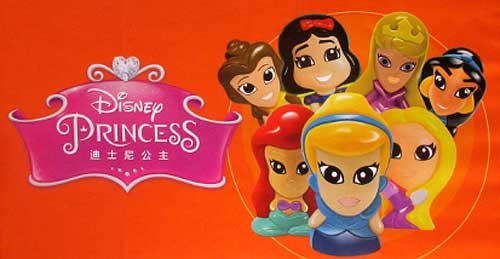
Photo by Jim Hill
I'm assuming that some Disney Consumer Products exec is
hoping that Wikkeez will eventually become the new Tsum Tsum. But to be blunt,
these little hard plastic figures don't seem to have the same huggable charm
that those stackable plush do. But I've been wrong before. So let's see what
happens with Disney Wikkeez once they start showing up on the shelves of the
Company's North American retail partners.

Photo by Jim Hill
And speaking of Disney's retail partners … They were
meeting with Mouse House executives behind closed doors one floor down from the
official show floor for this year's Licensing Expo.
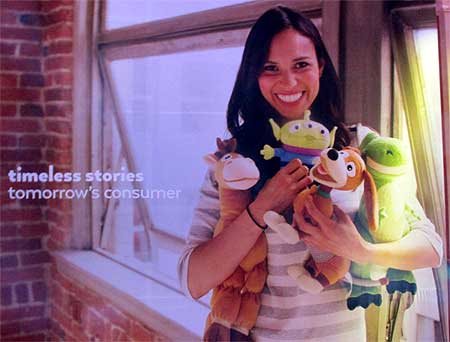
Photo by Jim Hill
And the theme for this year's invitation-only Disney shindig? "Timeless
Stories" involving the Disney, Pixar, Marvel & Lucasfilm brands that
would then appeal to "tomorrow's consumer."

Photo by Jim Hill
And just to sort of hammer home the idea that Disney is no
longer the Company which cornered the market when it comes to little girls
(i.e., its Disney Princess and Disney Fairies franchises), check out this
wall-sized Star Wars-related image that DCP put up just outside of one of its
many private meeting rooms. "See?," this carefully crafted photo
screams. "It isn't just little boys who want to wield the Force. Little
girls also want to grow up and be Lords of the Sith."

Photo by Jim Hill
One final, kind-of-ironic note: According to this banner,
Paramount Pictures will be releasing a movie called "Amusement Park"
to theaters sometime in 2017.
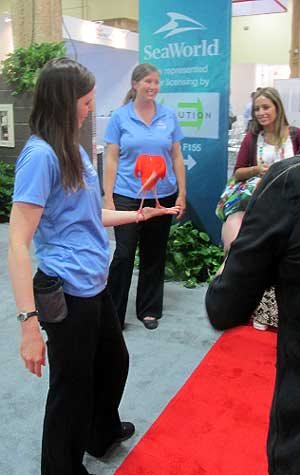
Photo by Jim Hill
Well, given all the "Blackfish" -related issues
that have been dogged SeaWorld Parks & Entertainment over the past two years, I'm
just hoping that they'll still be in the amusement park business come 2017.
Your thoughts?
General
It takes more than three circles to craft a Classic version of Mickey Mouse

You know what Mickey Mouse looks like, right? Little guy,
big ears?
Truth be told, Disney's corporate symbol has a lot of
different looks. If Mickey's interacting with Guests at Disneyland
Park (especially this summer, when
the Happiest Place on Earth
is celebrating its 60th anniversary), he looks & dresses like this.
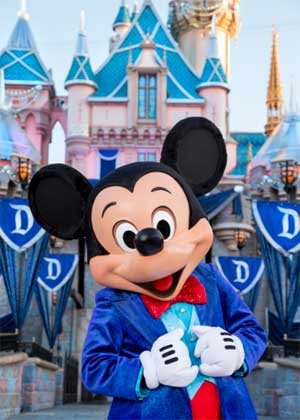
Copyright Disney Enterprises,
Inc.
All rights reserved
Or when he's appearing in one of those Emmy Award-winning shorts that Disney
Television Animation has produced (EX: "Bronco Busted," which debuts
on the Disney Channel tonight at 8 p.m. ET / PT), Mickey is drawn in a such a
way that he looks hip, cool, edgy & retro all at the same time.
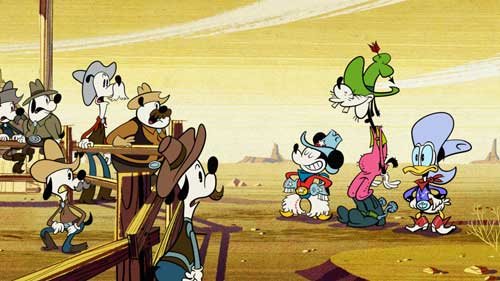
Copyright Disney Enterprises, Inc. All rights
reserved
Looking ahead to 2017 now, when Disney Junior rolls out "Mickey and the
Roadster Racers," this brand-new animated series will feature a sportier version
of Disney's corporate symbol. One that Mouse House managers hope will persuade
preschool boys to more fully embrace this now 86 year-old character.
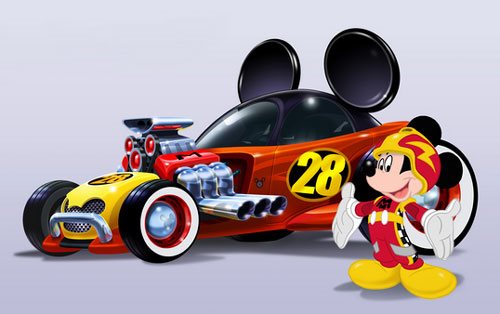
Copyright Disney Enterprises,
Inc. All rights reserved
That's what most people don't realize about the Mouse. The
Walt Disney Company deliberately tailors Mickey's look, even his style of
movement, depending on what sort of project / production he's appearing in.
Take — for example — Disney
California Adventure
Park's "World of Color:
Celebrate!" Because Disney's main mouse would be co-hosting this new
nighttime lagoon show with ace emcee Neil Patrick Harris, Eric Goldberg really had
to step up Mickey's game. Which is why this master Disney animator created
several minutes of all-new Mouse animation which then showed that Mickey was
just as skilled a showman as Neil was.
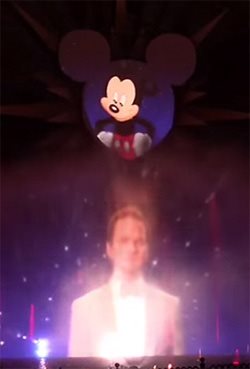
Copyright Disney Enterprises,
Inc.
All rights reserved
Better yet, let's take a look at what the folks at Avalanche Studios just went
through as they attempted to create a Classic version of Mickey & Minnie.
One that would then allow this popular pair to become part of Disney Infinity
3.0.
"I won't lie to you. We were under a lot of pressure to
get the look of this particular version of Mickey — he's called Red Pants
Mickey around here — just right," said Jeff Bunker, the VP of Art
Development at Avalanche Studios, during a recent phone interview. "When
we brought Sorcerer Mickey into Disney Infinity 1.0 back in January of 2014,
that one was relatively easy because … Well, everyone knows what Mickey Mouse
looked like when he appeared in 'Fantasia.' "
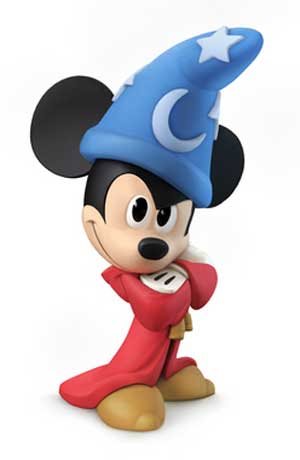
Copyright Disney Enterprises,
Inc. All rights reserved
"But this time around, we were being asked to design
THE Mickey & Minnie," Bunker continued. "And given that these Classic
Disney characters have been around in various different forms for the better
part of the last century … Well, which look was the right look?"
Which is why Jeff and his team at Avalanche Studios began watching hours &
hours of Mickey Mouse shorts. As they tried to get a handle on which look would
work best for these characters in Disney Infinity 3.0.
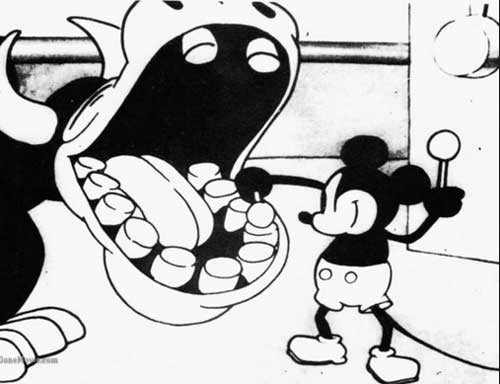
Copyright Disney
Enterprises, Inc. All rights reserved
"And we went all the way back to the very start of Mickey's career. We began
with 'Steamboat Willie' and then watched all of those black & white Mickey shorts
that Walt made back in the late 1920s & early 1930s. From there, we
transitioned to his Technicolor shorts. Which is when Mickey went from being
this pie-eyed, really feisty character to more of a well-behaved leading
man," Bunker recalled. "We then finished out our Mouse marathon by
watching all of those new Mickey shorts that Paul Rudish & his team have
been creating for Disney Television Animation. Those cartoons really recapture
a lot of the spirit and wild slapstick fun that Mickey's early, black &
white shorts had."
But given that the specific assignment that Avalanche Studios had been handed
was to create the most appealing looking, likeable version of Mickey Mouse
possible … In the end, Jeff and his team wound up borrowing bits & pieces
from a lot of different versions of the world's most famous mouse. So that
Classic Mickey would then look & move in a way that best fit the sort of
gameplay which people would soon be able to experience with Disney Infinity
3.0.
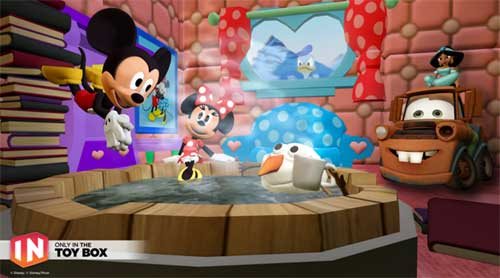
Copyright Disney Enterprises,
Inc. All rights reserved
"That — in a lot of ways — was actually the toughest
part of the Classic Mickey design project. You have to remember that one of the
key creative conceits of Disney Infinity
is that all the characters which appear in this game are toys," Bunker
stated. "Okay. So they're beautifully detailed, highly stylized toy
versions of beloved Disney, Pixar, Marvel & Lucasfilm characters. But
they're still supposed to be toys. So our Classic versions of Mickey &
Minnie have the same sort of thickness & sturdiness to them that toys have.
So that they'll then be able to fit right in with all of the rest of the
characters that Avalanche Studios had previously designed for Disney Infinity."
And then there was the matter of coming up with just the
right pose for Classic Mickey & Minnie. Which — to hear Jeff tell the
story — involved input from a lot of Disney upper management.
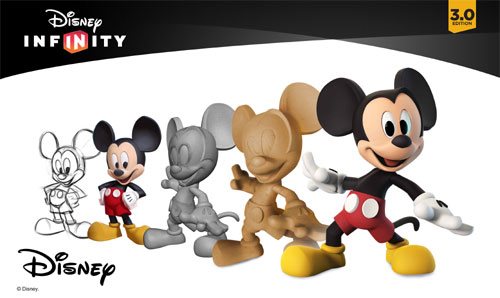
Copyright Disney Enterprises,
Inc. All rights reserved
"Everyone within the Company seemed to have an opinion
about how Mickey & Minnie should be posed. More to the point, if you Google
Mickey, you then discover that there are literally thousands of poses out there
for these two. Though — truth be told — a lot of those kind of play off the
way Mickey poses when he's being Disney's corporate symbol," Bunker said.
"But what I was most concerned about was that Mickey's pose had to work
with Minnie's pose. Because we were bringing the Classic versions of these
characters up into Disney Infinity 3.0 at the exact same time. And we wanted to
make sure — especially for those fans who like to put their Disney Infinity
figures on display — that Mickey's pose would then complement Minnie.
Which is why Jeff & the crew at Avalanche Studios
decided — when it came to Classic Mickey & Minnie's pose — that they
should go all the way back to the beginning. Which is why these two Disney icons
are sculpted in such a way that it almost seems as though you're witnessing the
very first time Mickey set eyes on Minnie.

Copyright Disney Enterprises,
Inc. All rights reserved
"And what was really great about that was — as soon as
we began showing people within the Company this pose — everyone at Disney
quickly got on board with the idea. I mean, the Classic Mickey that we sculpted
for Disney Infinity 3.0 is clearly a very playful, spunky character. But at the
same time, he's obviously got eyes for Minnie," Bunker concluded. "So
in the end, we were able to come up with Classic versions of these characters
that will work well within the creative confines of Disney Infinity 3.0 but at
the same time please those Disney fans who just collect these figures because
they like the way the Disney Infinity characters look."
So now that this particular design project is over, does
Jeff regret that Mouse House upper management was so hands-on when it came to
making sure that the Classic versions of Mickey & Minnie were specifically
tailored to fit the look & style of gameplay found in Disney Infinity 3.0?
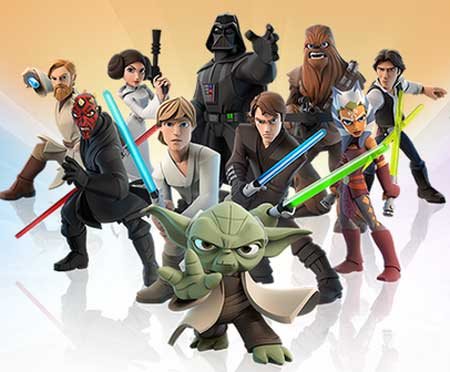
Copyright Lucasfilm / Disney
Enterprises, Inc. All rights reserved
"To be blunt, we go through this every time we add a new character to the
game. The folks at Lucasfilm were just as hands-on when we were designing the
versions of Darth Vader and Yoda that will also soon be appearing in Disney
Infinity 3.0," Bunker laughed. "So in the end, if the character's
creators AND the fans are happy, then I'm happy."
This article was originally posted on the Huffington Post's Entertainment page on Tuesday, June 9, 2015
-

 News & Press Releases11 months ago
News & Press Releases11 months agoDisney Will Bring D23: The Ultimate Disney Fan Event to Anaheim, California in August 2024
-

 History6 months ago
History6 months agoFrom Birthday Wishes to Toontown Dreams: How Toontown Came to Be
-

 History6 months ago
History6 months agoUnpacking the History of the Pixar Place Hotel
-

 History6 months ago
History6 months agoThe Evolution and History of Mickey’s ToonTown
-

 News & Press Releases5 months ago
News & Press Releases5 months agoNew Updates and Exclusive Content from Jim Hill Media: Disney, Universal, and More
-

 Film & Movies3 months ago
Film & Movies3 months agoHow Disney’s “Bambi” led to the creation of Smokey Bear
-

 Merchandise4 months ago
Merchandise4 months agoIntroducing “I Want That Too” – The Ultimate Disney Merchandise Podcast






